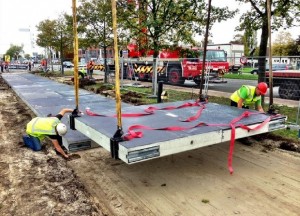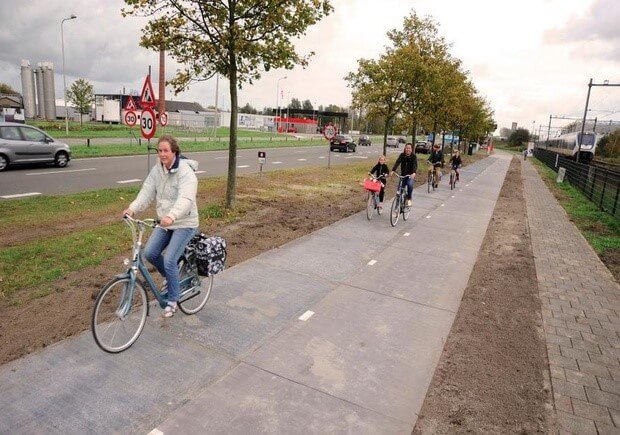Source: greenerideal.com
Published: November 11, 2014

Photo via SolaRoad
By Sarah Burke
The Netherlands are renowned for their huge population of cyclists. In fact, 27% of all trips nationwide are taken by bicycle, with higher numbers in cities and rural areas, such as Groningen which possibly boasts the largest number of cyclists with 59%.
The environmental advantages of such a system are obvious, and let’s not get started on the health benefits.
But if you thought that the Netherlands were going to sit back passively and watch as the world tries to catch up with their environmentally friendly ways, you’d be wrong. Instead, they just took things one step further with the world’s first solar-powered bike path.
The idea of solar panel roadways has been in development for years by various different sources. Simply put, people are trying to figure out ways to harness the power of the sunlight that falls on to the road surfaces. Putting solar panels into the roads means that solar energy is absorbed by solar cells and converted into electricity.
Basically, the road surface acts as a large solar panel.
The SolaRoad pilot project will officially open on November 12 in Krommenie, a town northwest of Amsterdam. The solar powered bike lane will be able to power street lights, and even houses. The project is the result of a collaboration of the government, the private sector, and academia.
The bike lane will allow riders to hop on at one end and then after a few seconds of pedalling, dismount on the other. Because the road is still just a pilot project, it’s only 230 feet long.
The SolaRoad consists of concrete modules each of 2.5 by 3.5 metres with solar cells that are fitted in one travelling direction underneath a tempered glass top layer which is approximately 1-cm thick.

Photo via SolaRoad
I know, it sounds a bit like a death trap.
But don’t worry – the road has been tested for safety and is outfitted with a friction-granting surface to ensure the cyclists don’t go for a skid any time soon:
“In the run-up to the surface being laid, the road was tested in the laboratory to ensure that it fulfils all (safety) requirements for road surfaces.”
The energy that the road produces will be used to power houses, street lights and electric cars.
The project will run for 3 years as the results are measured and the following questions are answered:
“How does it behave in practice? How much energy does it produce? and What is it like to cycle over?”
However, there are a variety of setbacks.
Firstly, the roads are unable to be angled towards the sun, so it’s not quite as efficient as traditional solar panels.
Secondly, the project comes at a huge cost of $3.1 million. In saying that, there are hopes that as the technology improves and catches on in other cities, that the costs of installing such technology will be reduced substantially.
Photo via SolaRoad
Dr. Sten de Wit from SolaRoad stated :
“This could be a breakthrough in the field of sustainable energy supply. In particular, if the road concept will develop into a system, with which the generated electricity is transported to the vehicles driving on the road.
Try to imagine that power will then be generated at the place where it is needed. Subsequently, a big step towards an energy-neutral mobility system will be possible.”
